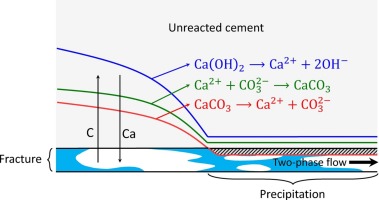International Journal of Greenhouse Gas Control ( IF 3.9 ) Pub Date : 2018-01-08 , DOI: 10.1016/j.ijggc.2017.12.001 Jaisree Iyer , Stuart D.C. Walsh , Yue Hao , Susan A. Carroll

|
Wellbore leakage tops the list of perceived risks to the long-term geologic storage of CO2, because wells provide a direct path between the CO2 storage reservoir and the atmosphere. In this paper, we have coupled a two-phase flow model with our original framework that combined models for reactive transport of carbonated brine, geochemistry of reacting cement, and geomechanics to predict the permeability evolution of cement fractures. This addition makes the framework suitable for field conditions in geological storage sites, permitting simulation of contact between cement and mixtures of brine and supercritical CO2.
Due to lack of conclusive experimental data, we tried both linear and Corey relative permeability models to simulate flow of the two phases in cement fractures. The model also includes two options to account for the inconsistent experimental observations regarding cement reactivity with two-phase CO2-brine mixtures. One option assumes that the reactive surface area is independent of the brine saturation and the second option assumes that the reactive surface area is proportional to the brine saturation.
We have applied the model to predict the extent of cement alteration, the conditions under which fractures seal, the time it takes to seal a fracture, and the leakage rates of CO2 and brine when damage zones in the wellbore are exposed to two-phase CO2-brine mixtures. Initial brine residence time and the initial fracture aperture are critical parameters that affect the fracture sealing behavior. We also evaluated the importance of the model assumptions regarding relative permeability and cement reactivity. Our results illustrate the need to understand how mixtures of carbon dioxide and brine flow through fractures and react with cement to make reasonable predictions regarding well integrity. For example, a reduction in the cement reactivity with two-phase CO2-brine mixture can not only significantly increase the sealing time for fractures but may also prevent fracture sealing.
中文翻译:

两相流对胶结井筒化学变化和泄漏通道封闭的评估
井眼泄漏是长期对CO 2进行地质储存的最大风险,因为井为CO 2储存储层与大气之间的直接通道提供了直接途径。在本文中,我们将两相流模型与我们的原始框架相结合,该模型结合了碳酸盐盐水的反应性传输模型,反应性水泥的地球化学和地质力学的模型,以预测水泥裂缝的渗透率演化。这种添加使该框架适用于地质存储地点的现场条件,从而可以模拟水泥与盐水和超临界CO 2的混合物之间的接触。
由于缺乏确凿的实验数据,我们尝试使用线性和Corey相对渗透率模型来模拟水泥裂缝中两相的流动。该模型还包括两个选项,以解释关于水泥与两相CO 2-盐水混合物的反应性不一致的实验观察结果。一种选择是假定反应性表面积与盐水饱和度无关,而第二种选择则假定反应性表面积与盐水饱和度成正比。
我们已经应用该模型预测了水泥蚀变的程度,裂缝封闭的条件,裂缝封闭的时间以及井眼中的破坏区暴露于两相时CO 2和盐水的泄漏率。CO 2-盐水混合物。初始盐水停留时间和初始裂缝孔径是影响裂缝密封行为的关键参数。我们还评估了有关相对渗透率和水泥反应性的模型假设的重要性。我们的结果表明需要了解二氧化碳和盐水的混合物如何流过裂缝并与水泥反应以对井的完整性做出合理的预测。例如,两相CO 2引起的水泥反应性降低卤水混合物不仅会大大增加裂缝的密封时间,而且可能会阻止裂缝的密封。



























 京公网安备 11010802027423号
京公网安备 11010802027423号